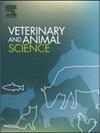超声监测妊娠和非妊娠犬黄体形态演变和血清黄体酮浓度:一项前瞻性观察研究
IF 1.9
Q2 AGRICULTURE, DAIRY & ANIMAL SCIENCE
引用次数: 0
摘要
黄体是犬在怀孕期间唯一产生黄体酮的结构。本研究的目的是表征母狗黄体的形态学变化,并评估其与体重、血清黄体酮浓度和多次吸收的关系。我们每周监测26只母狗,从排卵确认到排卵后35天,通过超声检查结合黄体酮检测测量黄体直径。妊娠率为80.7%(21/26),均足月妊娠。狗被分为小型(5-15公斤),中型(16-39公斤)和大型品种(40-65公斤)。狗体重显著影响平均黄体直径(P <;0.001),在确认排卵当天,小型犬的平均值±SD为3.4±0.5 mm,大型犬的平均值±SD为6.0±0.7 mm。从排卵确认到排卵高峰,黄体显著生长(2.1±1.2 mm);P & lt;0.001),并在第35天恢复到初始大小。令人惊讶的是,三分之一的最大黄体在进行随后的生理直径缩小之前超过了1cm。黄体直径的增长与血清黄体酮浓度呈正相关(P <;0.05)。本研究提供了犬黄体特征的新发现,这在以前的文献中没有描述,可以帮助排卵检测和区分生理和潜在的病理结构。本文章由计算机程序翻译,如有差异,请以英文原文为准。
Ultrasound monitoring of corpus luteum morphological evolution and serum progesterone concentration in pregnant and non-pregnant dogs: A prospective, observational study
The corpus luteum is the only structure producing progesterone during pregnancy in dogs. The aim of this study was to characterise morphological changes of corpora lutea in the bitch and assess their relationship with body weight, serum progesterone concentration, and multiple resorptions. We monitored 26 bitches weekly from ovulation confirmation to 35 days post-ovulation, measuring the corpora lutea diameter via ultrasound examination in combination with progesterone assays. The pregnancy rate was 80.7% (21/26), and all pregnancies were carried to term. Dogs were classified into small (5–15 kg), medium (16–39 kg), and large breeds (40–65 kg). Dog weight significantly influenced mean luteal diameter (P < 0.001), which ranged from a mean ± SD of 3.4 ± 0.5 mm for small dogs to 6.0 ± 0.7 mm for large dogs on the day of ovulation confirmation. From ovulation confirmation to peak, corpora lutea grew significantly (2.1 ± 1.2 mm; P < 0.001) and returned to their initial size by day 35. Surprisingly, one-third of maximum corpora lutea exceeded 1 cm before undergoing subsequent physiological diametric reduction. This growth in luteal diameter was positively correlated with serum progesterone concentration (P < 0.05). This study provides novel findings on canine corpus luteum characteristics, not previously described in literature, which could aid ovulation detection and differentiation between physiological and potentially pathological structures.
求助全文
通过发布文献求助,成功后即可免费获取论文全文。
去求助
来源期刊

Veterinary and Animal Science
Veterinary-Veterinary (all)
CiteScore
3.50
自引率
0.00%
发文量
43
审稿时长
47 days
 求助内容:
求助内容: 应助结果提醒方式:
应助结果提醒方式:


